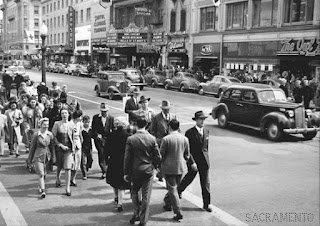The rise of modern photography just about coincides with the growth of Sacramento as a city and state capital of California. We have the iconic photographs to prove it. In fact, historians trace the birth of practical photography to 1837, and it grew steadily over the decades through the 19th century before exploding into the mainstream in the 1900s. Sacramento really took off as a gold rush community in the mid 1840s, and took a great step forward as a modern, functional city in the early 20th century. In part one of this blog, we took you on a trip down memory lane in Sacramento with 20 historic photos of the city.
Here are 20 more photos our beloved Sacramento from yesteryear, spanning from the mid 1800s to the 1970s.
Whenever possible, we told you where, when, and even why the photo was taken.
The Crocker Art Museum in 1893. Crocker Art is still iconic in Sacramento today!
In 1972, a small plane crashed into a Sacramento residential neighborhood, tragically killing 22 people as it slammed into Farrell's Ice Cream Parlor.
This is the Sacramento Bee headline the next morning.
The Sacramento residence of Dr. WM Moore in 1900.
The Flagstone Motel on 1530 W. Capitol Avenue in the 1960s.
Front Street in Sacramento in the 1860s - one of the first photographs of Sacramento in existence.
The Sacramento Governor's Mansion in 1907.
The Great Depression of the 1930s hit Sacramento hard, like many western communities and the whole nation. This is a photo of a woman living in the American River Migrant Camp during the Great Depression.
Another shot of a family at the American River Camp in 1936.
The original Guild Theater! Year unknown.
Old Town Sacramento turned into a river for months during the historic floods of 1861-62, which led the city planners to raise most of the downtown streets and establishments.
Levinson's Book Store on K Street around 1924.
Another shot of K Street in the 1940s.
Midtown Sacramento 1920s.
An advertisement for the new Parkway Estates real estate development, which is near Florin Road and Stockton Blvd. By the way, the phone number on the ad is just "2-0621"
J Street Sacramento in the 1900s, including the cable car.
Sacramento Fire Department with horses and carriages!
K Street Sacramento during the snow storm of 1942.
Hotel Berry, downtown Sacramento in the 1920s or 30s.
A 1950s postcard for the Sacramento "Business District."
Sacramento in the 1840s!
Sacramento aerial view from 1857. How did they get this shot? Hot air balloon? Or is it just a drawing?
Another photo of K Street during the snowstorm of 1942.
A squatter's camp in Sacramento during the Great Depression.
The Mansion, built in 1877.
The urbanization of Sacramento, as the city grows up and becomes a thriving community.




































